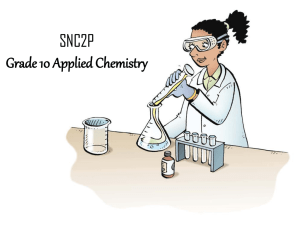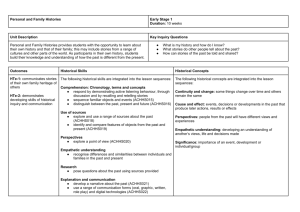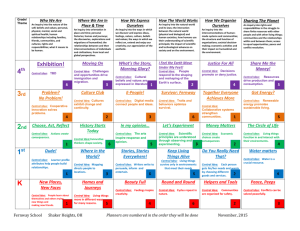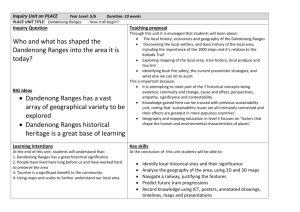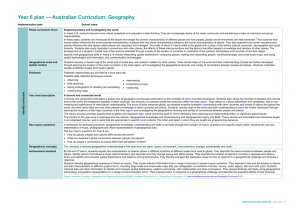File - Caringbah North PS
advertisement
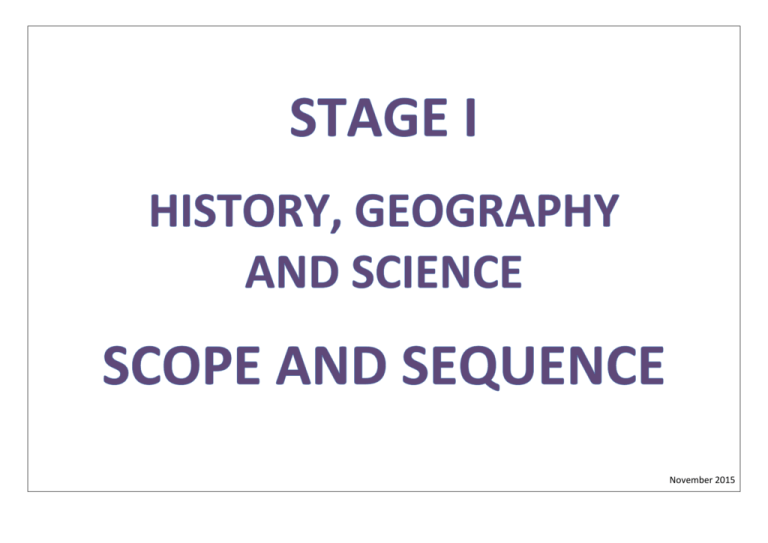
November 2015 STAGE 1 CURRICULUM OVERVIEW – History and Geography Semester 1 Year 1 Year 2 Semester 2 Past and Present Family Life HT1-1, HT1-4 (H029) Past and Present Family Life HT1-1, HT1-4 (H028, H030) People and Places GE1-1, GE1-3 (G005, G006) People and Places GE1-1, GE1-3 (G009, G010) The Past in the Present HT1-2, HT1-3, HT1-4 (H044, H045) The Past in the Present HT1-2, HT1-4 (H046) People and Places GE1-1, GE1-3 (G010, G011, G012 – Local and Global) People and Places GE1-1, GE1-3 (G007, G008, G013) STAGE 1 CURRICULUM OVERVIEW – Science Even Term1 Term 2 Term 3 Term 4 Physics Earth and Space Chemistry Biology 1-6PW (Light and Sound) Physics Odd 1-7PW Push and Pull 1-8ES (Weather and Seasons) Earth and Space 1 -9ES Care for the Environment 1-16P Products 1-12MW Changes and purposes 1-14BE Built Environments Chemistry 1-13MW Range and purposes 1-10LW Living Things (Mini-beasts) Biology 1-11LW Living Things (Mini-beasts) 1-15I Information Semester 1 Outcomes Key Inquiry Questions 1 HISTORY – Present and Past Family Life GEOGRAPHY – Features of Places HT1-1 communicates an understanding of change and continuity in family life using appropriate historical terms HT1-4 demonstrates skills of historical inquiry and communication GE1-1 describes features of places and the connections people have with places GE1-2 identifies ways in which people interact with and care for places GE1-3 communicates geographical information and uses geographical tools for inquiry • How has family life changed or remained the same over time? • How can we show that the present is different from or similar to the past? • How do we describe the sequence of time? What are the features of, and activities in, places? How can we care for places? How can spaces within a place be used for different purposes? H029 How the present, past and future are signified by terms indicating time such as 'a long time ago', 'then and now', 'now and then', 'old and new', 'tomorrow', as well as by dates and changes that may have personal significance, such as birthdays, celebrations and seasons G005 Features of Places Students: investigate features of places and how they can be cared for, for example: - description of the natural and human features of places ST VR - discussion of the natural features of places identified in Aboriginal Dreaming stories and/or Legends of the Torres Strait - consideration of how a place can be cared for eg a park, farm, beach, bushland Students: • sequence days of the week, months and seasons of the year (Comprehension) • identify days, holidays, events celebrated by students and their families and discuss cultural differences in days celebrated (Empathetic understanding) • define and use terms relating to time, sequencing objects or photographs from the past, eg then and now, past and present, a long time ago G006 Weather and Seasons Students: investigate the weather and seasons of places, for example: -description of the daily and seasonal weather patterns of a familiar place -comparison of the daily and seasonal weather patterns of places GS -examination of how different cultural groups, including Aboriginal or Torres Strait Islander Peoples, describe weather, seasons or seasonal calendars VR -discussion of how weather can affect places and activities eg leisure, farming Semester 2 Outcomes Key Inquiry Questions 1 HISTORY – Present and Past Family Life GEOGRAPHY – People and Places HT1-1 communicates an understanding of change and continuity in family life using HT1-4 demonstrates skills of historical inquiry and communication GE1-1 describes features of places and the connections people have with places GE1-3 communicates geographical information and uses geographical tools for inquiry • How has family life changed or remained the same over time? • How can we show that the present is different from or similar to the past? • How do we describe the sequence of time? Where are places located in Australia? How are people connected to places? What factors affect people’s connections to places? H 028 Differences in family structures and roles today, and how these have changed or remained the same over time (Explanation and communication) G009 Australia’s Location Students: investigate Australia’s location in the world, for example: -description of Australia’s location in relation to the world eg continents, oceans M appropriate historical terms H 030 Differences and similarities between students' daily lives and life during their parents' and grandparents' childhoods, including family traditions, leisure time and communications Students: • represent graphically the structure of their immediate family • compare and contrast their immediate family with earlier families through photographs and other sources, discussing similarities and differences (Perspectives) • investigate the roles of present family members and compare with the roles of earlier generations using a range of sources (Use of sources ) • discuss similarities and differences from generation to generation, eg family celebrations and traditions, leisure activities and changes in technology/communications over time through a range of sources • compare and contrast daily life with that of parents and grandparents at the same age through stories or photographs and pose questions to ask parents/grandparents (Research) G0010 Australian Places Students: investigate places across a range of scales within Australia, for example: -identification that places exist across a range of scales eg personal, local, national M VR Semester 1 Outcomes HISTORY – The Past in the Present GEOGRAPHY – People and Places HT1-2 identifies and describes significant people, events, places and sites in the local community HT1-4 demonstrates skills of historical inquiry and communication GE1-1 describes features of places and the connections people have with places GE1-3 communicates geographical information and uses geographical tools for inquiry • What aspects of the past can you see today? • What do they tell us? • What remains of the past are important to the local community? Why? Where are places located in Australia? How are people connected to places? What factors affect people’s connections to places? H044 The history of a significant person, building, site or part of the natural environment in the local community and what it reveals about the past G011 and G012 Local and Global Connections Students: investigate connections that people, including Aboriginal and Torres Strait Islander Peoples, have to local and global places, for example: -discussion of Aboriginal and Torres Strait Islander Peoples’ connections with land, sea and animals of their place -description of reasons people are connected to places in Australia and/or countries across the world eg birthplace M over time Key Inquiry Questions 2 Students: • brainstorm what aspects of the past can be seen in the local area • identify a significant person, building, site or part of the natural environment in the local community and discuss what they reveal about the past and why they are considered important • investigate an aspect of local history develop a narrative on their chosen aspect of local history which focuses on the remains of the past (Research/Explanation and communication) H045 The importance today of an historical site of cultural or spiritual significance; for example, a community building, a landmark, a war memorial Students: • identify an historical site or sites in the local community. Discuss their significance, why these sites have survived and the importance of preserving them (Empathetic understanding) • examine local or regional Aboriginal and Torres Strait Islander sites, eg local national parks Semester 2 HISTORY – Present and Past Family Life GEOGRAPHY – Features of Places/ People and Places HT1-3 describes the effects of changing technology on people's lives over time HT1-4 demonstrates skills of historical inquiry and communication GE1-1 describes features of places and the connections people have with places GE1-2 identifies ways in which people interact with and care for places GE1-3 communicates geographical information and uses geographical tools for inquiry • What aspects of the past can you see today? • What do they tell us? • How have changes in technology shaped our daily life? What are the features of, and activities in, places? How can spaces within a place be used for different purposes? How are people connected to places? What factors affect people’s connections to places? H046 The impact of changing technology on people’s lives Students: • identify examples of changing technologies in their home or community • discuss the similarities (Use of sources) • define and use terms relating to time, sequencing objects or photographs from the past, eg then and now, past and present, a long time ago (Comprehension) G007 and G008 How places are organised Students: investigate activities that occur within places, for example: -discussion of why and how the spaces within places can be rearranged for different purposes eg street fair, school hall VR -examination of why various activities in an area are located where they are eg school, shops M F Outcomes Key Inquiry Questions 2 G013 People’s connections to places Students: investigate people’s connections and access to places, for example: -discussion of why people visit other places GS -identification of factors influencing people’s accessibility to places eg distance M -examination of how technology has improved people’s access to places
